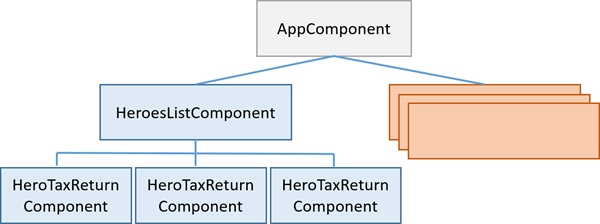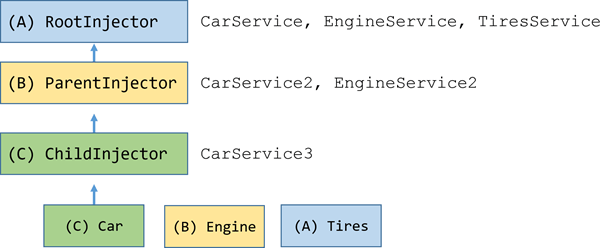We learned the basics of Angular Dependency injection in the Dependency Injection chapter.
Angular has a Hierarchical Dependency Injection system. There is actually a tree of injectors that parallel an application's component tree. We can reconfigure the injectors at any level of that component tree with interesting and useful results.
In this chapter we explore these points and write some code.
Try the
The Injector Tree
In the Dependency Injection chapter we learned how to configure a dependency injector and how to retrieve dependencies where we need them.
We oversimplified. In fact, there is no such thing as the injector! An application may have multiple injectors!
An Angular application is a tree of components. Each component instance has its own injector! The tree of components parallels the tree of injectors.
Angular doesn't literally create a separate injector for each component. Every component doesn't need its own injector and it would be horribly inefficient to create masses of injectors for no good purpose.
But it is true that every component has an injector (even if it shares that injector with another component) and there may be many different injector instances operating at different levels of the component tree.
It is useful to pretend that every component has its own injector.
Consider a simple variation on the Tour of Heroes application consisting of three different components:
HeroesApp, HeroesListComponent and HeroesCardComponent.
The HeroesApp holds a single instance of HeroesListComponent.
The new twist is that the HeroesListComponent may hold and manage multiple instances of the HeroesCardComponent.
The following diagram represents the state of the component tree when there are three instances of HeroesCardComponent
open simultaneously.

Each component instance gets its own injector and an injector at one level is a child injector of the injector above it in the tree.
When a component at the bottom requests a dependency, Angular tries to satisfy that dependency with a provider registered in that component's own injector. If the component's injector lacks the provider, it passes the request up to its parent component's injector. If that injector can't satisfy the request, it passes it along to its parent component's injector. The requests keep bubbling up until we find an injector that can handle the request or run out of component ancestors. If we run out of ancestors, Angular throws an error.
There's a third possibility. An intermediate component can declare that it is the "host" component. The hunt for providers will climb no higher than the injector for this host component. We'll reserve discussion of this option for another day.
Such a proliferation of injectors makes little sense until we consider the possibility that injectors at different levels can be configured with different providers. We don't have to reconfigure providers at every level. But we can.
If we don't reconfigure, the tree of injectors appears to be flat. All requests bubble up to the root
NgModule injector that we configured with the bootstrap method.
The ability to configure one or more providers at different levels opens up interesting and useful possibilities.
Let’s return to our Car example.
Suppose we configured the root injector (marked as A) with providers for Car, Engine and Tires.
We create a child component (B) that defines its own providers for Car and Engine
This child is the parent of another component (C) that defines its own provider for Car.
Behind the scenes each component sets up its own injector with one or more providers defined for that component itself.
When we resolve an instance of Car at the deepest component (C),
its injector produces an instance of Car resolved by injector (C) with an Engine resolved by injector (B) and
Tires resolved by the root injector (A).

Component Injectors
In the previous section, we talked about injectors and how they are organized like a tree. Lookups follow the injector tree upwards until they find the requested thing to inject. But when do we actually want to provide providers on the root injector and when do we want to provide them on a child injector?
Consider you are building a component to show a list of super heroes that displays each super hero in a card with its name and superpower. There should also be an edit button that opens up an editor to change the name and superpower of our hero.
One important aspect of the editing functionality is that we want to allow multiple heroes to be in edit mode at the same time and that one can always either commit or cancel the proposed changes.
Let’s take a look at the HeroesListComponent which is the root component for this example.
lib/heroes_list_component.dart
Notice that it imports the HeroService that we’ve used before so we can skip its declaration. The only difference is that we’ve used a more formal approach for our Heromodel and defined it upfront as such.
lib/hero.dart
Our HeroesListComponent defines a template that creates a list of HeroCardComponents and HeroEditorComponents, each bound to an instance of hero that is returned from the HeroService. Ok, that’s not entirely true. It actually binds to an EditItem<Hero> which is a simple generic datatype that can wrap any type and indicate if the item being wrapped is currently being edited or not.
lib/edit_item.dart
But how is HeroCardComponent implemented? Let’s take a look.
lib/hero_card_component.dart
The HeroCardComponent is basically a component that defines a template to render a hero. Nothing more.
Let’s get to the interesting part and take a look at the HeroEditorComponent
lib/hero_editor_component.dart
Now here it’s getting interesting. The HeroEditorComponentdefines a template with an input to change the name of the hero and a cancel and a save button. Remember that we said we want to have the flexibility to cancel our editing and restore the old value? This means we need to maintain two copies of our Hero that we want to edit. Thinking ahead, this is a perfect use case to abstract it into its own generic service since we have probably more cases like this in our app.
And this is where the RestoreService enters the stage.
lib/restore_service.dart
All this tiny service does is define an API to set a value of any type which can be altered, retrieved or set back to its initial value. That’s exactly what we need to implement the desired functionality.
Our HeroEditComponent uses this services under the hood for its hero property. It intercepts the get and set method to delegate the actual work to our RestoreService which in turn makes sure that we won’t work on the original item but on a copy instead.
At this point we may be scratching our heads asking what this has to do with component injectors?
Look closely at the metadata for our HeroEditComponent. Notice the providers property.
This adds a RestoreService provider to the injector of the HeroEditComponent.
Couldn’t we simply alter our bootstrap arguments to include this provider?
web/main.dart (bad-alternative)
Technically we could, but our component wouldn’t quite behave the way it is supposed to. Remember that each injector treats the services that it provides as singletons. However, in order to be able to have multiple instances of HeroEditComponent edit multiple heroes at the same time we need to have multiple instances of the RestoreService. More specifically, each instance of HeroEditComponent needs to be bound to its own instance of the RestoreService.
By configuring a provider for the RestoreService on the HeroEditComponent, we get exactly one new instance of the RestoreServiceper HeroEditComponent.
Does that mean that services aren’t singletons anymore in Angular? Yes and no. There can be only one instance of a service type in a particular injector. But we've learned that we can have multiple injectors operating at different levels of the application's component tree. Any of those injectors could have its own instance of the service.
If we defined a RestoreService provider only on the root component,
we would have exactly one instance of that service and it would be shared across the entire application.
That’s clearly not what we want in this scenario. We want each component to have its own instance of the RestoreService.
Defining (or redefining) a provider at the component level creates a new instance of the service for each new instance
of that component. We've made the RestoreService a kind of "private" singleton for each HeroEditComponent,
scoped to that component instance and its child components.